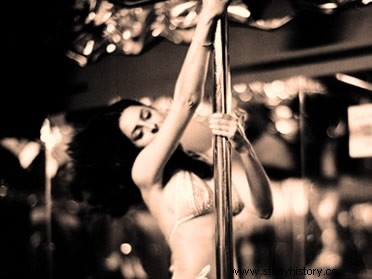
In 1917, the audience of the little National Winter Garden I expected another artistic presentation filled with jokes , sexy dancers and the presentation of monologues . At one point, the mostly male audience came across a performance by comedian Mae Dix . The actress, worried about the cost of maintaining her costume, unpretentiously removed the collar of her dress. The gesture made onstage left the men in the room in an uproar.
Noticing the warm reaction from the audience, Mae removed the cuffs of her clothing and began to unbutton her dress. That simple gesture ended up resulting in the invention of one of the most popular and controversial performances in entertainment:the strip-tease . The owners of the establishment, the Minsky brothers , took advantage of the moment to establish a regular presentation where Mae, from then on, would come to “undress provoking”.
However, the American invention was created just before a century marked by morality and legal punishment for the so-called “lewd acts ”. In fact, since the end of the 19th century, the so-called burlesque theater it was a popular attraction filled with malicious and provocative background banter. In order not to explicitly infringe the customs and laws of the time, the artistic directors of these performances appealed to the “faithful reproduction” of stagings from the Greco-Roman theater to justify the dancers' tiny parts.
In general, the opening found for this type of appealing spectacle was made through the tableaux vivants (living pictures), in which models represented classical paintings and classical situations were enacted. Immovable, the models exposed their bodies to “educate” a public not always interested in Arts or History. Among the most staged paintings, the reproduction of “The Birth of Venus” by Sandro Botticelli stood out. .
On the European continent, strict moral standards were also an obstacle for striptease to become popular. In the 19th century the rigid moral standards of the Victorian Era they were strong enough to scrutinize the costumes an actress could wear on stage. The first to extrapolate these standards was the British theater company of Lydia Thompson . In her show, dancers wore skin-tight clothes in shades that created the illusion of nudity.
During the same period, the so-called “skirt dancers” appeared, who lulled audiences to performances of cancã . At the same time, the famous oriental dancers used shows inspired by dance movements considered exotic to Western eyes. Another popular performance was thebelly dance , which shifted the cultural motivations of the Arab spectacle to the interest of male audiences.
In burlesque theater, Mae's disinterested action ended up taking on even more creative and theatrical contours. Jessica Glasscok , who studies the subject, emphasizes that striptease was not limited to the simple and objective exposure of the female body. It was necessary, according to the author, to have a triad of elements where fun, provocation and exhibition were mixed up in a presentation loaded with a distance from the public.
The creativity imbued in these paintings does seem to confirm Glassock's perspective. Some dancers took the stage with their bodies covered by trained birds that flew during the show. Others covered themselves with balloons that had to be popped one by one. The rise of these performances in the US ended up prompting, once again, the creation of a law against this type of improper performance.
Only in the late 1950s and with the sexual revolution of the 1960s, that we see the revival of striptease shows. One of the best known of this era was Bettie Page , considered an icon of the so-called “pin-ups”. The pin-ups today they represent a “revival” of female conquests against the moral standards that have long governed the behavior of contemporary society.
